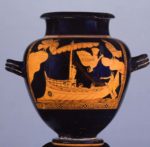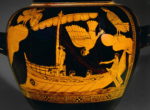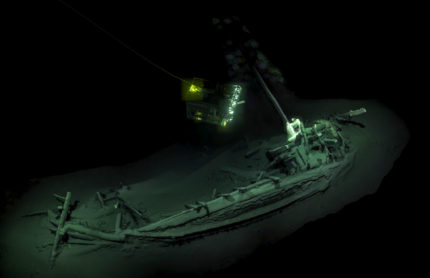 The long story and vertiginous conclusion of your faithful narrator’s two-day quest to get a picture of yet another random artifact will be soon told in (excessive) detail, but it’ll take me a while to get the pictures leading up to THE picture sorted, so while I’m winging over ocean I guess I’ll let the Black Sea Maritime Archaeology Project get a little attention. Its researchers have discovered the oldest known intact shipwreck, a merchant vessel of Greek design previously only seen on the side of Greek vases.
The long story and vertiginous conclusion of your faithful narrator’s two-day quest to get a picture of yet another random artifact will be soon told in (excessive) detail, but it’ll take me a while to get the pictures leading up to THE picture sorted, so while I’m winging over ocean I guess I’ll let the Black Sea Maritime Archaeology Project get a little attention. Its researchers have discovered the oldest known intact shipwreck, a merchant vessel of Greek design previously only seen on the side of Greek vases.
It was found a little over a mile below the surface of the dark, cold Black Sea, preserved in mind-boggling detail by the lack of oxygen and wood-devouring organism. The ship is 75 feet long and is resting comfortably on the sea floor complete with mast, rudders and rowing benches.
“A ship surviving intact from the classical world, lying in over 2km of water, is something I would never have believed possible,” said Professor Jon Adams, the principal investigator with the Black Sea Maritime Archaeology Project (MAP), the team that made the find. “This will change our understanding of shipbuilding and seafaring in the ancient world.” […]
The team reportedly said they intended to leave the vessel where it was found, but added that a small piece had been carbon dated by the University of Southampton and claimed the results “confirmed [it] as the oldest intact shipwreck known to mankind”. The team said the data would be published at the Black Sea MAP conference at the Wellcome Collection in London later this week.
 With so much of it intact, the ship can be identified as the same type depicted on the Siren Vase in the British Museum. The Siren Vase, believed to have been found in the Etruscan necropolis of Vulci but made in Attica, dates to 480-470 B.C., the same period as the ship. It pictures Odysseus tied to the mast to resist the song of the sirens who surround him. Six oars are visible on the port side.
With so much of it intact, the ship can be identified as the same type depicted on the Siren Vase in the British Museum. The Siren Vase, believed to have been found in the Etruscan necropolis of Vulci but made in Attica, dates to 480-470 B.C., the same period as the ship. It pictures Odysseus tied to the mast to resist the song of the sirens who surround him. Six oars are visible on the port side.
I can’t tell from the photo of the shipwreck how many oars it had, but it looks to me that there are seven or eight rowing benches extant, so very similar in size to the imaginary vessel on the vase. It’s pretty amazing to picture Odysseus’ rowers perched on those benches.

I’m sure you had a lovely time in Rome – so good that it caused you to mix up your geography? Black sea and Baltic Sea are quite a bit apart 🙂
A Greek vessel of that era in the Baltic, now *that* would be a find!
Ha, the right wing nuts would love a conspiracy on that scale. Greek vessel in the Baltic! Must be aliens!..lol
Still, what a fantastic find!
Keep in mind:…
“Neither by ship nor on foot would you find the marvellous road to the assembly of the Hyperboreans [Ὑπερβόρειοι]” (Pindar). Obviously, a (pen)insula beyond the “North Wind”, and not the tin islands (Britain) or anything around the Ister/Danube, but instead further up north. Of course, the ‘Baltic Sea area’ is only one –of many– theories for the location of the ‘true’ Hyperborea. Common sense, however, seems to have been that Hyperborea is ‘beyond the Skyths’ as ‘beyond the Boreas’.
Diodorus Siculus: “we shall now discuss the electron, as it is called [Baltic] amber. Directly opposite the part of Scythia, which lies above Galatia, there is an island out in the open sea which is called Basileia. On this island the waves of the sea cast up great quantities of what is known as amber, which is to be seen nowhere else in the inhabited world”.
From a (later) Roman point of view, although, Tacitus personally was never there: “In producing of grain and the other fruits of the earth, they labour with more assiduity and patience than is suitable to the usual laziness of Germans. Nay, they even search the deep, and of all the rest are the only people who gather amber. They call it glesum, and find it amongst the shallows and upon the very shore. But, according to the ordinary incuriosity and ignorance of Barbarians, they have neither learnt, nor do they inquire, what is its nature, or from what cause it is produced. In truth it lay long neglected amongst the other gross discharges of the sea; till from our luxury, it gained a name and value. To themselves it is of no use: they gather it rough, they expose it in pieces coarse and unpolished, and for it receive a price with wonder.” (AD 98, ‘Germania’, chapter XLV).
:skull: Androphagi (Ἀνδροφάγοι, “man-eaters”) were, according to Herodotus, an ancient nation of cannibals north of Scythia, probably in the forests between the upper waters of the Dnepr and Don. Here, M. Gimbutas hypothesized that the term ‘Androphagoi’ is a Greek translation of *mard-xwaar “man-eater” in the old North Iranian language of the Scythians. From *mard-xwaar one can derive “Mordva” or “Mordvin”, the Russian name of the Finno-Ugrian Erzya and Moksha peoples of east-central European Russia.
Those “Hyperboreans” lived beyond the Skythians and beyond he ‘Maneaters’ (in the Don area) and reached the [norhern] sea (..τούτων δὲ τοὺς Ὑπερβορέους κατήκοντας ἐπὶ θάλασσαν), which pretty much would indeed indicate the ‘Baltic Sea’, wouldn’t it? 🙂
I’m guessing you mean the Black Sea. The Baltic Sea is shallower than two km, and is oxygenated throughout its volume.
Baltic, Black – hurray, Diversity!
^^ Actually the Baltic Sea has quite a problem with low oxygen levels.
“Right wing nuts”?
How pathetic of you.
Baltic, Black, they all look the same.
https://www.zerohedge.com/news/2018-10-29/they-all-look-same-hillary-cracks-racist-joke-after-bookerholder-mix
Right Wing Nuts? Leave it to an obvious nut job lefty to turn even news of a discovery that has absolutely nothing to do with modern day politics into something to use to (albeit weakly) criticize the other side. What a tool. Ha … lol!
I’ve always wanted to explore shipwrecks like this and find gold!